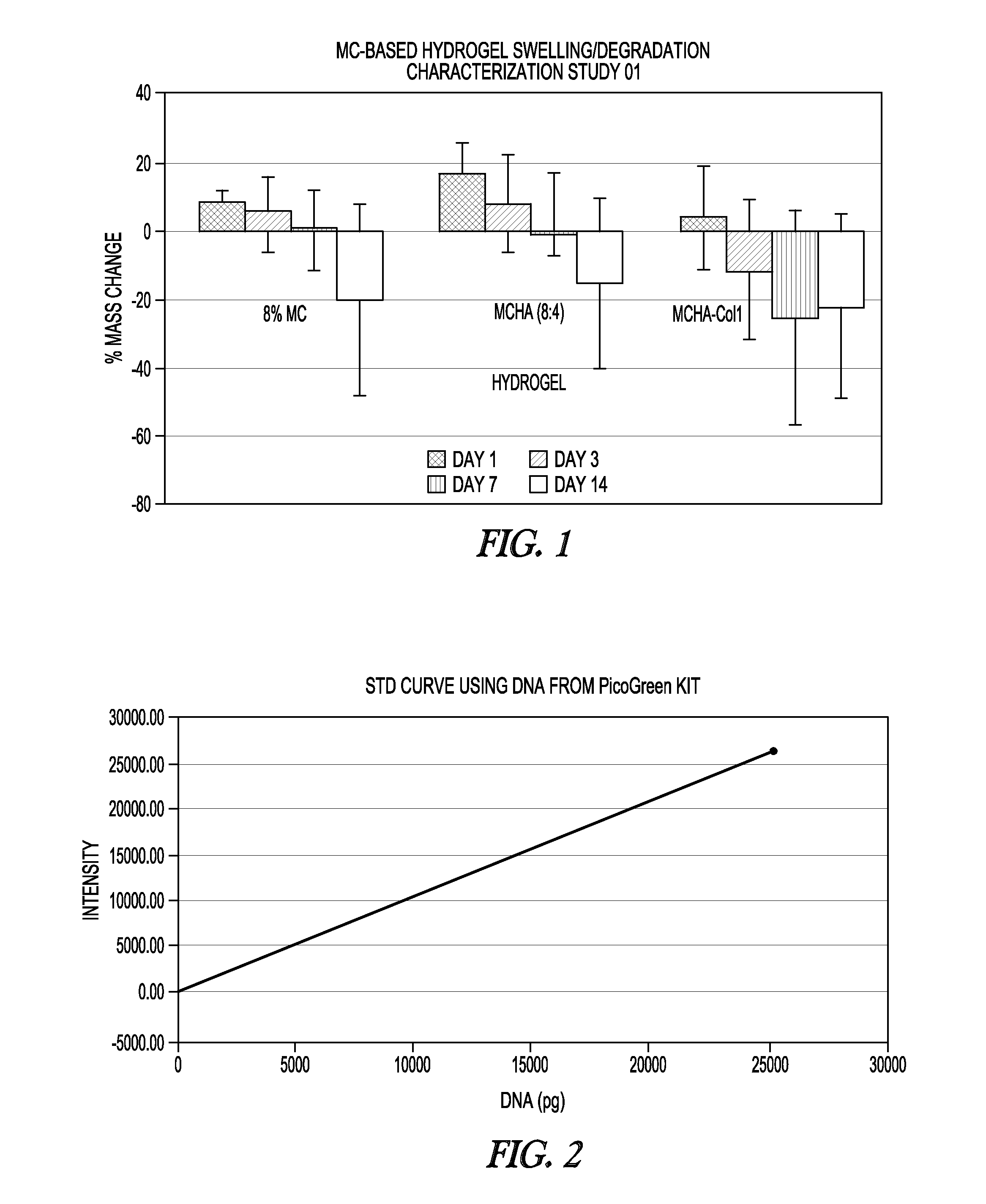Thermosensitive hydrogel composition and method
a technology of hydrogel and composition, applied in the field of hydrogel, can solve the problem of insufficient gelling speed of methyl cellulose alone, and achieve the effects of improving cell adhesion, promoting healing, and supplencing viscosity
- Summary
- Abstract
- Description
- Claims
- Application Information
AI Technical Summary
Benefits of technology
Problems solved by technology
Method used
Image
Examples
example 1
[0032]In all the Examples herein, rheological properties including storage modulus (G′), loss modulus (G″), and complex modulus (G*) were measured on a model MCR 101 rheometer available from Anton Paar using a 25 mm serrated plate. The hydrogel samples were in the form of cylinders having a thickness of about 1 to about 2 mm and a diameter slightly greater than the rheometer plate. The top and bottom surfaces of the cylinder sample were flat. The bottom plate temperature was about 35 to about 37° C. The sample was placed between the bottom plate and the serrated plate with 600 grit sandpaper.
[0033]The amplitude sweep was used to test the linear range of the hydrogel, and the frequency sweep was used to test the storage, loss, and complex modulus. The strain was at about 1% if the hydrogel had a linear range over about 1%; otherwise, a lower strain was used. The frequency range was about 0.1 to about 100 s-1. Twenty-four measuring points were taken for each sample. There was an inter...
example 2
Preparation of Methyl Cellulose-Hyaluronic Acid-Type II Collagen Hydrogel Forming Composition
[0038]In a beaker, 150 mL of sterile 1× Dulbecco's phosphate-buffered saline (D-PBS) is heated to 90° C. To the heated saline are added 8 g methyl cellulose powder (Sigma, catalog #M7140, 14,000 m.w.), then 2 g hyaluronic acid (Engelhard, catalog #HA-501 100-1, batch #565608), then another 8 g of methylcellulose powder, with thorough mixing after each addition, for about 30 minutes of mixing. To this heated mixture is added about 5 mg of type II collagen as a stock solution of about 2.98 mg / mL (BD Biosciences, catalog #354257, lot #008794), with continued mixing for 10 minutes. Immediately, 50 mL of 1×PBS at 4° C. is added to obtain a volume of 200 mL. The mixture contains 8% methylcellulose, 2% hyaluronic acid, and 0.0025% collagen type II, measured as w / v. Mixing continues at 4° C. in an ice bath for 30 minutes. The final mixture is stored overnight at 4° C. prior to use.
[0039]The hydrogel...
example 3
Preparation of Methyl Cellulose-Hyaluronic Acid-Type B Gelatin Hydrogel Forming Composition
[0041]All equipment and materials are sterilized in an autoclave by known methods to insure a sterile composition. In a 1 L media bottle with a mechanical stirrer is placed 300 mL of 1×PBS. To the bottle are added 2 g hyaluronic acid powder; the bottle is capped and the contents of the bottle are stirred continuously for 48 to 72 hours to ensure complete dissolution. The solution is then heated in a hot water bath to 90° C., with stirring. To the heated solution, 32 g of methylcellulose was slowly added; the contents were mixed while the bottle was loosely capped. This is followed by immediate vigorous shaking with the bottle tightly capped; the cap is then released briefly to release pressure. The bottle is place on ice to cool for about ten minutes. To the bottle is added type B gelatin (Sigma Aldrich) in the amount of 400 mg for a 0.1% w / w end product. To the bottle is then added 100 mL of ...
PUM
| Property | Measurement | Unit |
|---|---|---|
| Temperature | aaaaa | aaaaa |
| Molar density | aaaaa | aaaaa |
| Temperature | aaaaa | aaaaa |
Abstract
Description
Claims
Application Information
 Login to View More
Login to View More - R&D
- Intellectual Property
- Life Sciences
- Materials
- Tech Scout
- Unparalleled Data Quality
- Higher Quality Content
- 60% Fewer Hallucinations
Browse by: Latest US Patents, China's latest patents, Technical Efficacy Thesaurus, Application Domain, Technology Topic, Popular Technical Reports.
© 2025 PatSnap. All rights reserved.Legal|Privacy policy|Modern Slavery Act Transparency Statement|Sitemap|About US| Contact US: help@patsnap.com


